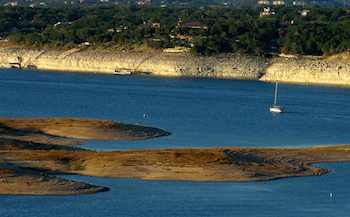
As the drought continues to tighten its grip on Texas, many communities are taking a serious look at their water supplies. Factors under consideration include supply management review, implementing methods to extend current water supplies, and adding additional water supplies in an attempt to hedge against drought. Water management strategies that previously may have been out of the question for a water utility may now make sense. For example, most utilities did not fund residential and commercial-scale rainwater collection but now they are common. Every drop that we can add to our water supply portfolio makes sense and the cost-effective options are especially attractive.
The City of Austin is one city that is taking a closer look at their water supplies. In April of this year, Austin City Council gathered a group of stakeholders to examine the drought’s impact on the city’s water supplies and to make recommendations on what should be done to reduce risk for Austin residents. Lone Star Chapter staff member Jennifer Walker served on the Austin Water Resource Planning Task Force along with 10 other stakeholders from the Austin area. The Task Force spent about six weeks assessing Austin’s current water supplies and made recommendations to Council about actions they should take. The report was submitted to City Council in June and while it focuses on near and mid-term measures to mitigate the impact of drought, it contains a variety of recommendations that could easily apply to many cities in Texas at all times.
The Task Force recommended that Austin Water continue to focus on reducing per capita water use through the implementation of robust public education campaigns and additional programs that will enable customers of all sizes to reduce water use both during and between droughts. Conservation is the most cost effective and least environmentally harmful method that we can employ to enhance our water supplies. The Task Force also found that using the water we already have more efficiently makes sense and is more preferable to importing water from other areas..
There are a number of additional efforts that the Task Force recommended Austin should do to improve its infrastructure to reduce its water losses and increase efficiency. For example, Longhorn Dam can be operated more efficiently to reduce water loss through the gates that release water downstream. Longhorn Dam impounds water from Lady Bird Lake.
Another option is to more efficiently use the storage capability of Decker Lake (Lake Walter E. Long) reservoir. Currently, the Decker is refilled with water from Lake Travis as water in Decker Lake is used or evaporates, To avoid taxing the Highland Lakes (Lake Travis is part of the Highland Lakes), which is Austin’s main water supply, Decker Lake could be allowed to capture local rainfall and runoff. The same principle could be applied to Lake Austin, another in the chain of lakes on the Colorado River, during non-recreation months.
Austin can also ramp up the construction and deployment of its reclaimed water system. Reclaimed water can be used for cooling towers and outdoor irrigation, thus reducing these demands on the city’s potable water system. These and many other recommendations can be found in the Task Force report.
In addition to conservation, the Task Force was concerned with maintaining affordability. To address this, the Task Force recommended that water rates to meet basic needs must be affordable for every Austin resident. (Water for basic needs includes water used inside the home for activities such as cooking, bathing, toilet flushing, and laundry). Special attention also needs to be paid to rate structure so that rates are designed to cover the cost of doing business. Austin and other communities are struggling with generating adequate revenue to meet the rising cost of providing potable water while also faced with declining volumetric sales, due to a variety of factors including long-term watering restrictions because of the drought.
The Austin Water Resource Planning Task Force recommended that Austin Water Utility, along with other relevant city departments, develop an integrated water resource plan. Though it is not yet confirmed this will happen, Austin Water Utility may request funding for developing the plan in its FY 2015 budget. This would be a great opportunity to engage the Austin community in a thorough process to vet water supply options and to develop a long-term comprehensive plan for meeting future water demands.
This is also an exercise that other Texas cities can and should do.
Austin is half way through its fourth consecutive year of deep drought and the water supply reservoir that Austin and many other Central Texas communities rely on has been hovering around 39 percent full. While rain has been approaching average in the immediate Austin area and downstream, there has not been enough rain in the Highland Lakes watershed to replenish the lakes. Drought is part of life in Texas and communities have to take water use seriously and do all they can to live within their locally available water supply. This lesson is being brought home in a very real way lately.